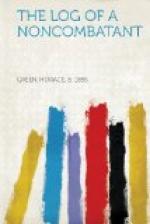When on Wednesday morning I was turned out of my room, I made my way past a pressing throng of foreign faces to the Queen’s Hotel on the water front. There I found Arthur Ruhl and James H. Hare, who had just come over from England. The hotel overlooked the River Scheldt, forming a wide crescent on the city’s north, and was within fifty yards of one of the longest pontoon bridges constructed in modern warfare.
Here was a sight to come again and rend the memory. The crowds were endeavoring to get away over one of the two avenues of escape still open. I estimated that between five in the afternoon and the following dawn three hundred thousand persons must have passed through the city’s gates. They were the people of Antwerp itself, swelled by exiles from Alost, Aerschot, Malines, Termonde, and other cities to the south and west. Intermittently for two days and nights I watched them from my room in the Queen’s. From five yards beneath my window ledge came the shuffle, shuffle of unending feet, the creak and groans of heavy cart wheels, the talk and babble of guttural tongues, the yelp of hounds, as the thousands moved and wept and surged and jostled along throughout the night and into the uncertain mist of that October morning. They were so close I could have jumped into their carts or dropped a pebble on their heads. Infinitely more impressive than the retreat of the allied armies or the victorious entry of the Germans a little later, was the pageant of this pitiful army without guns or leaders.
The twenty-foot entrance to that pontoon bridge seemed to me like the mouth of a funnel through which poured the dense misery of an entire nation. Think of this army’s composition: a great city was emptying itself of human life; not only a great city, but all the people driven to it from the outside, all who had congregated in Belgium’s last refuge and its strongest fort. They bore themselves bravely, the greater number plodding along silently in the footsteps of those who went ahead, with no thoughts of their direction, some of them even chatting and laughing. You saw great open wagons carrying baby carriages, perambulators, pots and kettles, an old chair, huge bundles of household goods, and the ubiquitous Belgian bicycle strapped to the side. There were small wagons, and more great wagons crowded with twenty, thirty, forty people: aged brown women, buried like shrunk walnuts in a mass of shawls, girls sitting listlessly on piles of straw, and children fitfully asleep or very much awake and crying lustily.
Sometimes the men and boys mounted their bicycles, rode for a dozen yards, were stopped by the procession, and then, for want of better occupation, rang their bells. One saw innumerable yelping dogs: big Belgian police hounds harnessed to the cart and doing their share of work, others sniffing along the outskirts and plainly advertising for an owner. There were noisy cattle, too, some of which escaped. Long after the city was evacuated I saw a cow bellowing under an archway of the Cathedral of Notre Dame.




